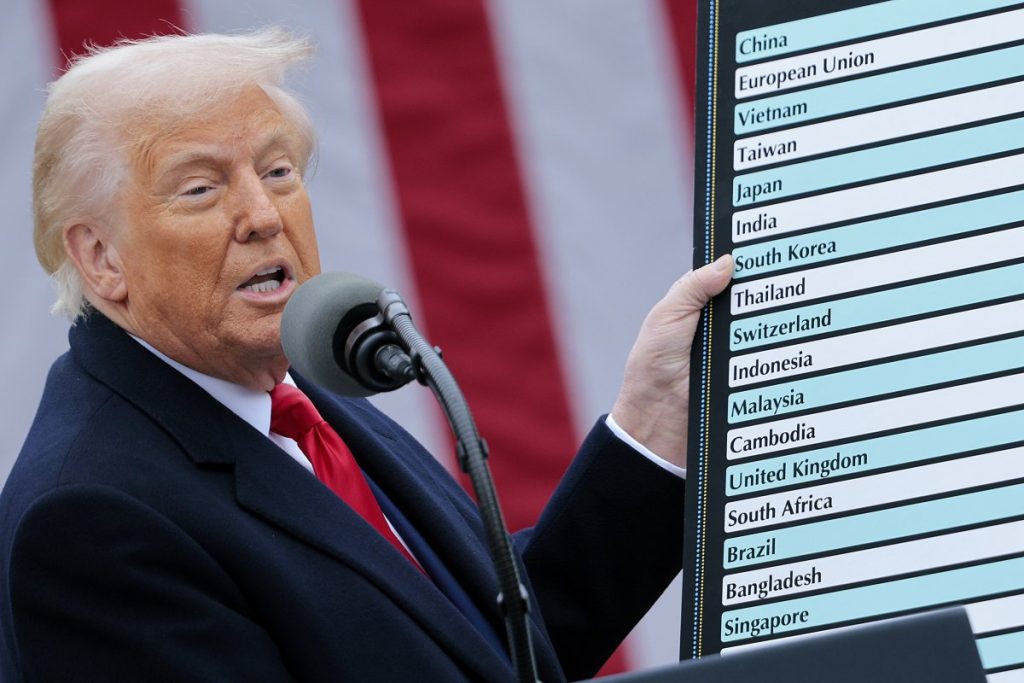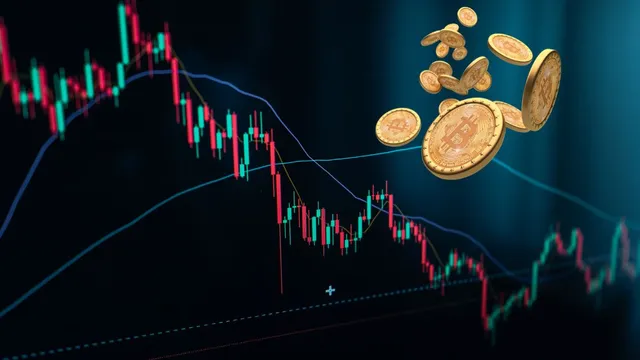How Trump’s Tariff Shake-Up Is Sending Ripples Through the Crypto Market?

Introduction: A New Era of Economic Uncertainty

On April 3, 2025, former President Donald Trump announced sweeping new tariffs, escalating global trade tensions and shaking investor confidence across markets. While traditional financial sectors reacted swiftly, the ripple effects on the cryptocurrency market were both immediate and complex. As global investors brace for a new round of economic friction, Bitcoin and the broader crypto ecosystem are once again under the microscope. For both seasoned investors and crypto newcomers, understanding these dynamics is critical.
Understanding the Immediate Market Reaction

The announcement of sweeping tariffs by former President Donald Trump on April 3, 2025, sent shockwaves through global financial markets, and the cryptocurrency sector was no exception. Bitcoin, the flagship cryptocurrency, saw its price dip below $82,000, marking a significant decline. This drop was mirrored by sharp losses in crypto-related stocks, with Coinbase and MicroStrategy experiencing declines of approximately 7% and 10%, respectively. The broader crypto market, including Ethereum and altcoins, also faced turbulence, reflecting the interconnectedness of digital assets with macroeconomic trends.
This immediate reaction highlights a critical dynamic: while cryptocurrencies are decentralized and often touted as independent of traditional financial systems, they remain deeply influenced by global economic sentiment. The tariffs, which included a baseline 10% levy on all imports and higher rates for specific countries, intensified fears of a global trade war. Such geopolitical developments tend to heighten investor uncertainty, prompting a shift toward risk-off assets like the U.S. dollar and government bonds. As a result, speculative assets like cryptocurrencies often experience sell-offs during these periods of heightened volatility.
Historically, Bitcoin has been perceived as a hedge against traditional market instability, often referred to as “digital gold.” During periods of inflation or currency devaluation, Bitcoin has attracted investors seeking an alternative store of value. However, its behavior during acute market shocks, such as the recent tariff announcement, reveals its dual nature. While it can act as a hedge in the long term, Bitcoin’s short-term price movements are highly sensitive to shifts in liquidity and risk sentiment. For instance, during the U.S.–China trade tensions in 2019, Bitcoin initially rallied as a safe-haven asset but later mirrored broader market volatility.
The recent tariff-induced market reaction also underscores the growing role of institutional investors in the crypto space. As institutions increasingly allocate capital to digital assets, cryptocurrencies are becoming more correlated with traditional financial markets. This correlation was evident in the synchronized decline of equities and crypto assets following the tariff announcement. Analysts have noted that Bitcoin’s price movements are now influenced by macroeconomic factors such as real yields, rate expectations, and dollar strength. This evolving dynamic challenges the narrative of crypto as an entirely uncorrelated asset class.
Risk Sentiment and Crypto Correlation

The cryptocurrency market has long been influenced by broader investor sentiment, often acting as a barometer for risk appetite. During periods of heightened uncertainty—such as tariff wars, inflationary pressures, or geopolitical conflicts—investors tend to adopt a “risk-off” approach. This means they pull capital out of volatile assets like cryptocurrencies and redirect it toward traditional safe havens such as bonds, gold, or the U.S. dollar. The recent tariff announcement by former President Donald Trump on April 3, 2025, exemplifies this dynamic. Bitcoin, Ethereum, and other cryptocurrencies experienced sharp sell-offs as investors sought stability amid fears of escalating trade tensions and their potential impact on the global economy.
Historically, Bitcoin has been perceived as a hedge against inflation and currency devaluation, earning it the moniker “digital gold.” However, its behavior during acute market shocks reveals a more nuanced relationship with traditional financial markets. For instance, during the U.S.–China trade tensions in 2019, Bitcoin initially rallied as a safe-haven asset but later mirrored broader market volatility. Similarly, the recent tariff-induced sell-off highlights Bitcoin’s sensitivity to liquidity shifts and macroeconomic factors. Institutional investors, who now play a significant role in the crypto market, often adjust their portfolios in response to these external pressures, further amplifying price movements.
Despite these challenges, Bitcoin’s recovery after its brief dip below $82,000 suggests a maturing market. The presence of long-term holders, often referred to as “HODLers,” and the growing influence of institutional investors have introduced a stabilizing effect. Unlike earlier crypto cycles characterized by extreme volatility, the current market benefits from a more diverse investor base and improved infrastructure. For example, the approval of spot Bitcoin ETFs in 2024 has provided a regulated avenue for institutional participation, increasing liquidity and reducing the likelihood of panic-driven sell-offs. According to a report by BeInCrypto, Bitcoin ETFs saw significant outflows ahead of the tariff announcement, reflecting cautious sentiment among institutional investors. However, the subsequent stabilization indicates that long-term confidence in the asset class remains intact.
The evolving correlation between cryptocurrencies and traditional financial markets also underscores the industry’s maturation. While Bitcoin and other digital assets were initially celebrated for their lack of correlation with equities and bonds, their integration into institutional portfolios has created new dynamics. Analysts have observed that Bitcoin’s price movements are increasingly influenced by macroeconomic indicators such as real yields, rate expectations, and dollar strength. This growing interconnectedness challenges the narrative of crypto as an entirely uncorrelated asset class but also highlights its potential to serve as a bridge between traditional and decentralized finance.
Implications for Digital Payments and E-Commerce

The imposition of tariffs has far-reaching consequences for global trade, increasing costs for goods and services and disrupting supply chains. These economic pressures are particularly pronounced in cross-border transactions, where traditional payment systems often struggle with inefficiencies such as high fees, slow settlement times, and currency fluctuations. In this challenging environment, cryptocurrencies are emerging as a transformative solution, offering businesses and consumers faster, cheaper, and more resilient payment options, much like crypto payment gateways aim to provide.
One of the most significant advantages of cryptocurrencies in this context is their ability to facilitate cross-border payments with minimal friction. Stablecoins, such as USDT and USDC, have become particularly popular for international transactions due to their price stability and near-instant settlement capabilities. Unlike traditional payment systems, which rely on multiple intermediaries and can take days to process, stablecoin transactions are completed within minutes on blockchain networks, streamlining processes like crypto invoices. This efficiency not only reduces costs but also enhances cash flow for businesses operating in tariff-affected regions. According to a report by Crypto.com, stablecoins are increasingly being adopted by e-commerce platforms and payment processors to streamline cross-border transactions and mitigate the impact of tariffs.
Layer 2 solutions, such as the Lightning Network for Bitcoin and Optimism for Ethereum, further enhance the utility of cryptocurrencies in digital payments. These technologies address scalability issues by processing transactions off-chain and then settling them on the main blockchain, significantly reducing fees and congestion. For instance, the Lightning Network enables microtransactions with fees as low as fractions of a cent, making it an ideal solution for e-commerce businesses looking to optimize their payment infrastructure. Insights from BitPinas highlight how Layer 2 solutions are being integrated into payment platforms to offer seamless and cost-effective services.
In addition to facilitating payments, cryptocurrencies provide businesses with tools to hedge against currency fluctuations in tariff-affected regions. Tariffs often lead to volatile exchange rates, creating uncertainty for businesses engaged in international trade. By holding and transacting in stablecoins, companies can protect themselves from currency devaluation and maintain predictable pricing. This capability is particularly valuable for startups and small businesses that lack access to sophisticated financial instruments.
Decentralized finance (DeFi) tools are also playing a crucial role in providing liquidity options for businesses operating in unstable markets. DeFi platforms enable companies to access decentralized lending and borrowing services, offering an alternative to traditional financial institutions. For example, businesses can use DeFi protocols to secure short-term loans in stablecoins, ensuring liquidity during periods of economic uncertainty. The adoption of DeFi solutions is growing rapidly, as highlighted in a recent analysis by Citizen Digital, which underscores their potential to revolutionize financial services in the face of global trade disruptions.
For businesses and startups, the implications are clear: optimizing payment infrastructure with crypto tools is no longer just a forward-thinking strategy—it is becoming a necessity. By leveraging stablecoins, Layer 2 solutions, and DeFi tools, companies can navigate the challenges posed by tariffs and position themselves for long-term success in an increasingly digital and interconnected economy.
What Should Investors and Startups Watch For?

The shifting macroeconomic landscape is presenting both challenges and opportunities for investors and startups in the cryptocurrency space. As global trade dynamics evolve under the influence of tariffs, inflation, and geopolitical tensions, several critical trends are emerging that warrant close attention.
One of the most significant developments is the regulatory response to the growing role of cryptocurrencies in international trade. Governments worldwide are moving toward more structured frameworks to address the complexities of digital assets. In the United States, the Securities and Exchange Commission (SEC) has pivoted from strict enforcement to strategic support, focusing on policies that encourage innovation while ensuring compliance. Similarly, the European Union’s Markets in Crypto-Assets (MiCA) regulation is setting a global benchmark by providing clear guidelines for crypto issuers and service providers. Asia is also making strides, with countries like South Korea and Singapore fostering blockchain innovation through balanced regulatory environments. These efforts are creating a more predictable and stable environment for crypto adoption in trade and commerce.
Institutional activity in the crypto market is another area to watch closely. Traditional financial players are reassessing the role of cryptocurrencies as inflation and tariffs reshape global economic conditions. The approval of spot Bitcoin ETFs in the U.S. has marked a turning point, attracting significant institutional capital and increasing market liquidity. This institutional interest is not limited to Bitcoin; Ethereum and other altcoins are also gaining traction as diversified portfolio assets. The growing involvement of institutions is helping to stabilize the market, reducing the extreme volatility that has historically characterized the crypto space.
Stablecoin adoption is accelerating, particularly in e-commerce and remittances, where fiat currency volatility poses significant challenges. Stablecoins like USDT and USDC are increasingly being used for cross-border payments, offering faster settlement times and lower fees compared to traditional methods. In Asia, stablecoins are gaining momentum as financial institutions and e-commerce platforms integrate them into their operations. This trend is not only enhancing efficiency but also providing a hedge against currency fluctuations in tariff-affected regions.
Emerging blockchain-based trade solutions are transforming how businesses manage supply chains and commodities. Tokenized commodities, such as digital gold and oil, are making traditional assets more accessible to a broader range of investors. Smart contract-based systems, like those potentially offered through smart contract services, are automating supply chain processes, reducing costs, and increasing transparency. These innovations are enabling businesses to navigate the complexities of global trade with greater efficiency and reliability.
Conclusion: Crypto as a Strategic Hedge in a Changing World
Trump’s new tariffs mark more than just a political maneuver—they signal a new phase of global economic reshuffling. For the crypto market, this presents both risks and opportunities. While short-term volatility is inevitable, the long-term trajectory suggests deeper integration of blockchain and digital assets in global finance.
Whether you’re a crypto investor, a digital payment provider, or simply trying to understand the evolving landscape, one thing is clear: staying informed and agile is essential. The world is changing fast—and crypto is right at the center of it.

